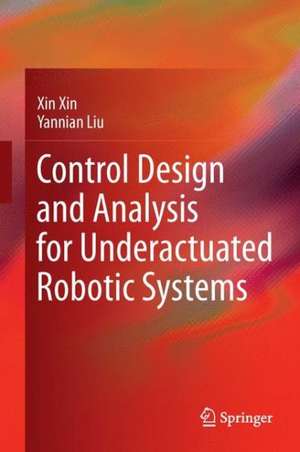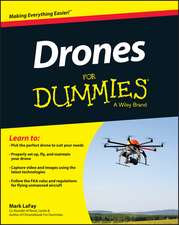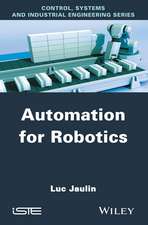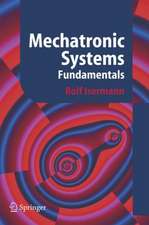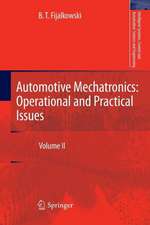Control Design and Analysis for Underactuated Robotic Systems
Autor Xin Xin, Yannian Liuen Limba Engleză Hardback – 16 ian 2014
Control Design and Analysis for Underactuated Robotic Systems includes the modelling, control design and analysis presented in a systematic way particularly for the following examples:
l directly and remotely driven Acrobots
l Pendubot
l rotational pendulum
l counter-weighted Acrobot
2-link underactuated robot with flexible elbow joint
l variable-length pendulum
l 3-link gymnastic robot with passive first joint
l n-link planar robot with passive first joint
l n-link planar robot with passive single joint
double, or two parallel pendulums on a cart
l 3-link planar robots with underactuation degree two
2-link free flying robot
The theoretical developments are validated by experimental results for the remotely driven Acrobot and the rotational pendulum.
Control Design and Analysis for Underactuated Robotic Systems is intended for advanced undergraduate and graduate students and researchers in the area of control systems, mechanical and robotics systems, nonlinear systems and oscillation. This text will not only enable the reader to gain a better understanding of the power and fundamental limitations of linear and nonlinear control theory for the control design and analysis for these URSs, but also inspire the reader to address the challenges of more complex URSs.
| Toate formatele și edițiile | Preț | Express |
|---|---|---|
| Paperback (1) | 786.71 lei 38-44 zile | |
| SPRINGER LONDON – 30 apr 2017 | 786.71 lei 38-44 zile | |
| Hardback (1) | 956.81 lei 6-8 săpt. | |
| SPRINGER LONDON – 16 ian 2014 | 956.81 lei 6-8 săpt. |
Preț: 956.81 lei
Preț vechi: 1166.84 lei
-18% Nou
Puncte Express: 1435
Preț estimativ în valută:
183.08€ • 191.67$ • 151.49£
183.08€ • 191.67$ • 151.49£
Carte tipărită la comandă
Livrare economică 05-19 aprilie
Preluare comenzi: 021 569.72.76
Specificații
ISBN-13: 9781447162506
ISBN-10: 1447162501
Pagini: 340
Ilustrații: XVII, 319 p. 111 illus., 94 illus. in color. With online files/update.
Dimensiuni: 155 x 235 x 24 mm
Greutate: 0.77 kg
Ediția:2014
Editura: SPRINGER LONDON
Colecția Springer
Locul publicării:London, United Kingdom
ISBN-10: 1447162501
Pagini: 340
Ilustrații: XVII, 319 p. 111 illus., 94 illus. in color. With online files/update.
Dimensiuni: 155 x 235 x 24 mm
Greutate: 0.77 kg
Ediția:2014
Editura: SPRINGER LONDON
Colecția Springer
Locul publicării:London, United Kingdom
Public țintă
ResearchCuprins
Fundamental Background.- Directly Driven Acrobat.- Remotely Driven Acrobat.- Pendubot.- Rotational Pendulum.- Counter-Weighted Acrobot.- Variable Length Pendulum.- 2-Link Underactuated Robot with Flexible Elbow Joint.- 3-Link Planar Robot with Passive First Joint.- n-Link Planar Robot with Passive First Joint.- n-Link Planar Robot with Single Passive Joint.- Two Parallel Pendulums on a Cart.- Double Pendulum on a Cart.- 3-Link Planar Robot with Two Passive Joints.- 2-Link Flying Robot.
Recenzii
“The book will be convenient for the reader who aims at analyzing the behavior of underactuated systems and developing new numerical and analytical control tools for these systems. The book is intended for undergraduate and graduate students, and researchers in the area of control systems, mechanical and robotic systems, nonlinear systems and oscillation.” (Clementina D. Mladenova, Mathematical Reviews, April, 2017)
Notă biografică
Xin Xin received the B.S. degree in 1987 from the University of Science and Technology of China, China and Ph.D. degree in 1993 from the Southeast University, China. From 1991 to 1993, under the guidance of professor Hidenori Kimura, he did his Ph.D. studies in Osaka University as a co-advised student of China and Japan with the Japanese Government Scholarship. He also received the Doctor degree in engineering in 2000 from Tokyo Institute of Technology. From 1993 to 1995, he was a postdoctoral researcher and then became an associate professor in Southeast University. From 1996 to 1997, he was with the New Energy and Industrial Technology Development, Japan as an advanced industrial technology researcher. From 1997 to 2000, he was an assistant professor of Tokyo Institute of Technology. From 2000, he has been with Okayama Prefectural University as an associate professor, where he is now a professor since 2008. He has over 140 publications in journals, international conferences and book chapters. He received the division paper award of SICE Conference on Control Systems in 2004. His current research interests include robotics, dynamics and control of nonlinear and complex systems.
He has been concentrating on studying URSs for more than a decade. The corresponding research results have been published in 12 international journal papers including IEEE Trans. on Automatic Control, Automatica, IEEE Trans. on Robotics, IEEE Trans. on Control Technology, International Journal of Robust and Nonlinear Control and about 40 refereed conference papers mainly in IEEE Conference on Decision and Control and IFAC world congress.
Yannian Liu received the B.S. degree in electrical engineering from Sichuan University, Chengdu, China in 1988 and the M. S. and Ph.D. from Southeast University, Nanjing, China in 1991 and 1994, respectively. From 1994-1995 she was a postdoctoral researcher in Nanjing University of Aeronautics and Astronautics. From 1996 she was an associate professor in the Control Department of Southeast University. From 1997 to 1999, she was a visiting scholar in the Department of Control and Systems Engineering of Tokyo Institute of Technology. From 2007 to 2010, she was working in the Solution Division of MoMo Alliance Co., Ltd. Okayama, Japan. Her current research interests include robot control and neural network. She has about 20 publications in journals and international conferences and has two Japanese patents.
He has been concentrating on studying URSs for more than a decade. The corresponding research results have been published in 12 international journal papers including IEEE Trans. on Automatic Control, Automatica, IEEE Trans. on Robotics, IEEE Trans. on Control Technology, International Journal of Robust and Nonlinear Control and about 40 refereed conference papers mainly in IEEE Conference on Decision and Control and IFAC world congress.
Yannian Liu received the B.S. degree in electrical engineering from Sichuan University, Chengdu, China in 1988 and the M. S. and Ph.D. from Southeast University, Nanjing, China in 1991 and 1994, respectively. From 1994-1995 she was a postdoctoral researcher in Nanjing University of Aeronautics and Astronautics. From 1996 she was an associate professor in the Control Department of Southeast University. From 1997 to 1999, she was a visiting scholar in the Department of Control and Systems Engineering of Tokyo Institute of Technology. From 2007 to 2010, she was working in the Solution Division of MoMo Alliance Co., Ltd. Okayama, Japan. Her current research interests include robot control and neural network. She has about 20 publications in journals and international conferences and has two Japanese patents.
Textul de pe ultima copertă
The last two decades have witnessed considerable progress in the study of underactuated robotic systems (URSs). Control Design and Analysis for Underactuated Robotic Systems presents a unified treatment of control design and analysis for a class of URSs, which include systems with multiple-degree-of-freedom and/or with underactuation degree two. It presents novel notions, features, design techniques, and strictly global motion analysis results for these systems. These new materials are shown to be vital in studying the control design and stability analysis of URSs.
Control Design and Analysis for Underactuated Robotic Systems includes the modelling, control design, and analysis presented in a systematic way particularly for the following examples:
l directly and remotely driven Acrobots
l Pendubot
l rotational pendulum
l counter-weighted Acrobot
2-link underactuated robot with flexible elbow joint
l variable-length pendulum
l 3-link gymnastic robot with passive first joint
l n-link planar robot with passive first joint
l n-link planar robot with passive single joint
double, or two parallel pendulums on a cart
l 3-link planar robots with underactuation degree two
2-link free flying robot
The theoretical developments are validated by experimental results for the remotely driven Acrobot and the rotational pendulum.
Control Design and Analysis for Underactuated Robotic Systems is intended for advanced undergraduate and graduate students, and researchers in the area of control systems, mechanical and robotics systems, nonlinear systems and oscillation. This text will not only enable the reader to gain a better understanding of the power and fundamental limitations of linear and nonlinear control theory for the control design and analysis for these URSs, but also inspire the reader to address the challenges of more complex URSs.
Control Design and Analysis for Underactuated Robotic Systems includes the modelling, control design, and analysis presented in a systematic way particularly for the following examples:
l directly and remotely driven Acrobots
l Pendubot
l rotational pendulum
l counter-weighted Acrobot
2-link underactuated robot with flexible elbow joint
l variable-length pendulum
l 3-link gymnastic robot with passive first joint
l n-link planar robot with passive first joint
l n-link planar robot with passive single joint
double, or two parallel pendulums on a cart
l 3-link planar robots with underactuation degree two
2-link free flying robot
The theoretical developments are validated by experimental results for the remotely driven Acrobot and the rotational pendulum.
Control Design and Analysis for Underactuated Robotic Systems is intended for advanced undergraduate and graduate students, and researchers in the area of control systems, mechanical and robotics systems, nonlinear systems and oscillation. This text will not only enable the reader to gain a better understanding of the power and fundamental limitations of linear and nonlinear control theory for the control design and analysis for these URSs, but also inspire the reader to address the challenges of more complex URSs.
Caracteristici
Related source files available for download for the convenience of the reader Enables the reader to analyze the behaviour of these systems and to develop new control designs for these systems numerically and analytically Inspires the reader to address the challenges of more complex underactuated robotic systems Includes supplementary material: sn.pub/extras
